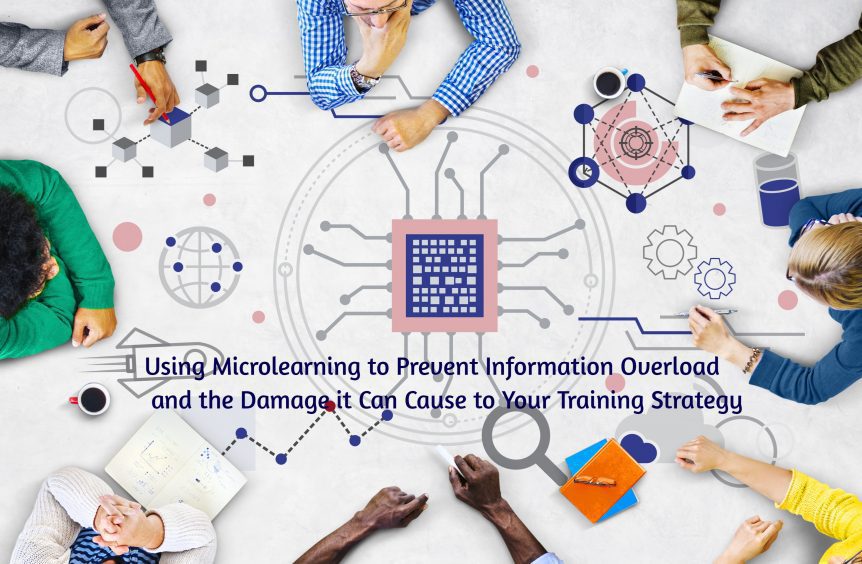Using Microlearning to Prevent Information Overload and the Damage it Can Cause to Your Training Strategy
Information overload has always been an issue when it comes to training. Whether it is the complexity of the topic, the unfamiliarity of the topic, or the state of mind of learners when they are completing the course, the central issue is the same – learners struggling to take on board the information they need to because they feel it is too much.
The result is poor retention rates which limit the performance and/or standards improvements you hoped the training would achieve.
Therefore, it’s important you take steps to prevent information overload as much as possible in your training courses.
One of the best ways to achieve this is to use a microlearning strategy as the structure of your e-learning course.
The Problem with Information Overload
Before looking at how microlearning can improve your e-learning courses that risk overwhelming learners, it’s important to understand that information overload is not a problem isolated to training.In fact, the impact of information overload on your training strategy is actually a side effect of a wider issue.
After all, information has never been more accessible than it is today. For a lot of us, we are bombarded with too much of it – emails that come in hourly or even more frequently, instant messages, notifications, social media updates, and more.
The result is often not an effort to get access to more information, but instead to find ways to condense the volume of information we receive and ensure our consumption of that information is efficient.
Many also strive to find time during the week where they can enjoy information blackouts away from their computer, phone, emails, and social media accounts.
When looked at from this perspective, it becomes more understandable when you receive an unenthusiastic response from learners on the announcement of a new training course. This is particularly true when the course topic is complex and/or unfamiliar.
Understanding the wider issue of information overload also gives clarity to the best solution to the problem.
Specifically, preventing information overload is not about giving incentives or trying to dumb down the content. Instead, you have to take a more strategic approach, i.e. an approach that involves microlearning.
What is Microlearning?
Microlearning is an e-learning strategy focused on course structure, content, and how content is delivered.
The most important element of a microlearning course is that the content is delivered to learners in bite-size chunks. What does this mean?
It means that learners can complete a section of your microlearning course in anything from a couple of minutes up to a maximum of five.
Furthermore, each chunk must be completely self-contained and should focus on one new idea, concept, or piece of information.
You can read some of our other blogs that cover the concept of microlearning in more detail as well as the wide range of benefits it offers.
However, what about the benefits specifically in relation to preventing information overload?
How Microlearning Prevents Information Overload
- You present the content to learners in brief sections – simply by giving the learner information in chunks, you reduce the strain, i.e. the learner doesn’t have to take as much in at one sitting.
- Learning doesn’t take up as much time – the time it takes to complete a course overall may be similar to a standard e-learning course, but learners don’t have to allocate much time to complete a single “chunk”. This facilitates good concentration.
- Can be completed in snippets – the short time it takes for learners to complete chunks of the course means they can proceed through the module at times that best suit them. A module in the five minutes before their lunch break ends, for example, three or four on the journey home from work, a couple in the evening while waiting for the oven to buzz indicating it’s finished, etc.
- Aids the learning process – as each chunk only focuses on a single new piece of information, it’s easier for learners to learn and remember. This prevents them from feeling overwhelmed.
- Gives confidence to learners – as already mentioned, with microlearning, learners don’t feel overwhelmed and they are learning, both of which will give them confidence. This puts the learner in a good state of mind which not only facilitates learning but also reduces feelings of information overload.
- The content is concise and to the point – by using a microlearning strategy for your course, both you and your e-learning developer in Dubai will have to focus on keeping the content in the course as concise and to the point as possible. After all, a chunk of a few minutes is not very long and has limited scope for detail. Therefore, only the most important content can be included, and all waffle must be removed. This eliminates superfluous information that can contribute to information overload.
- Promotes simplicity in course design – clean and simple designs are also a feature of microlearning courses. Again, this reduces what you present to the learner which helps to prevent information overload.
Using Microlearning as Part of Your Training Strategy
There are other benefits to using microlearning in your training strategy in addition to the above. Microlearning is adaptable to different course topics and different learners, for example, and it is flexible.
Of course, it won’t be the solution to all your course topics. If you are concerned about information overload with a specific course, however, microlearning is a training strategy you should consider implementing.
